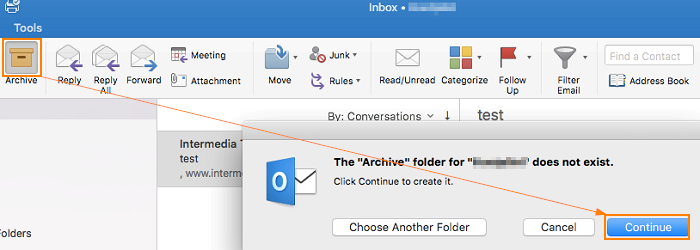- Outlook 2016 Mac File Location Download
- Outlook 2016 For Mac Data File Location
- Microsoft Outlook 2016 Data File Location Mac
- Outlook 2016 Mac File Location Software
- Outlook 2016 Mac File Location Folder
Select File in the top menu in Outlook. Click the Account Settings pull down menu, and then select Account Settings. In the Account Settings window, click the Data Files tab, then select the email account. The local Outlook Data file save path will be shown in the Location column. Note: The ability to manually repair or rebuild a database is not available in Outlook 2016 for Mac.If a problem such as Outlook data corruption occurs, Office 2016 for Mac automatically repairs and rebuilds the Office database for you. For more information, see About the Office 2016 for Mac database. To Archive Email in Outlook 2016 & 2011 for Mac, the user has to follow the different steps. When the user archive Mac Outlook data then the file created is known as an OLM file. The user can easily find mac Outlook 2016 archive location & create OLM file by following the steps given below. Create Outlook Mac Archive ( OLM ) File in Outlook 2016.
 -->
-->Original KB number: 2752583
Symptoms
When you try to change the location of the offline Outlook Data File (.ost) in Microsoft Outlook 2013 or later versions, the Browse button on the Outlook Data File Settings page is disabled.
Outlook 2016 Mac File Location Download
Cause
This issue occurs because of the deprecation of the classic offline mode in Outlook 2013 or later versions. This mode is a legacy data access method for online mode connections to Microsoft Exchange Server.
Workaround Method 1 - Create a new Outlook Profile and then change the location of the .ost file
Copy the existing
.ostfile to the new location that you want to use. If you want to create a new.ostfile instead, you can skip this step.Open Control Panel. To do this, use one of the following procedures, as appropriate for your version of Windows.
- Windows 10 and Windows 8: Press Windows Key, and then type Control Panel and then press OK.
- Windows 7: Select Start and then select Control Panel.
In Control Panel, type mail to search for the Mail item, and then open it. If there are two Mail items, choose the one that is labeled with your version of Outlook, such as Outlook 2013 or Outlook 15 for Outlook 2013, or Outlook 2016 or Outlook 16 for Outlook 2016 (The screenshot for this step is listed below).
Select Show Profiles.
Select Add (The screenshot for this step is listed below).
In the Profile Name box, type the name that you want to use for the new email profile, and then select OK (The screenshot for this step is listed below).
Select Next after Outlook finds your account information (The screenshot for this step is listed below).
After Outlook finishes the setup for your account, select the Change account settings option, and then select Next (The screenshot for this step is listed below).
In the Server Settings section, select More Settings (The screenshot for this step is listed below).
On the Advanced tab, select Outlook Data File Settings (The screenshot for this step is listed below).
Select Browse, browse to the
.ostfile that you copied in step 1, and then select Open. If you want to create a new.ostfile, browse to the location where you want to save the new.ostfile, type the file name that you want to use, and then select Open. Outlook will create the new.ostfile (The screenshot for this step is listed below).Select Finish to finish the setup for your email account.
Open Control Panel, and then open the Mail.
Select Always use this profile, select the new profile that you created, and then select OK (The screenshot for this step is listed below).

Workaround Method 2 - Set the ForceOSTPath registry entry to change the location of the .ost file

Note
Outlook 2016 For Mac Data File Location
The value of the ForceOSTPath registry entry only works for a new Outlook profile.
Important
Microsoft Outlook 2016 Data File Location Mac
This section, method, or task contains steps that tell you how to modify the registry. However, serious problems might occur if you modify the registry incorrectly. Therefore, make sure that you follow these steps carefully. For added protection, back up the registry before you modify it. Then, you can restore the registry if a problem occurs. For more information about how to back up and restore the registry, see How to back up and restore the registry in Windows.
Outlook 2016 Mac File Location Software
To set the ForceOSTPath registry entry in order to change the location of the .ost file, follow these steps:
Outlook 2016 Mac File Location Folder
Select Start, select Run, type regedit in the Open box, and then select OK.
Locate and then select the registry subkey:
HKEY_CURRENT_USERSoftwareMicrosoftOfficexx.0OutlookNote
The xx.0 placeholder represents your version of Office (16.0 = Office 2016, Office 365 and Office 2019, 15.0 = Office 2013).
Right-click Outlook, select New, and then select Expandable String Value.
Type ForceOSTPath, and then press Enter.
Right-click ForceOSTPath, and then select Modify.
In the Value data box, type the full path of where you want to store the
.ostfile (such as D:MyOST), and then select OK.On the File menu, select Exit to exit Registry Editor.
